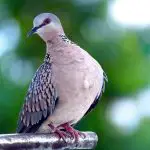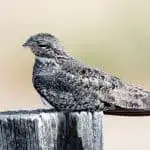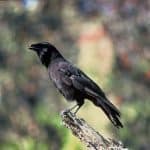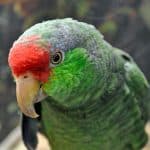Common Name: Mitred Parakeet
Scientific Name: (Psittacara mitratus)| Size | Diet | Range in Hawaii | Status in Hawaii |
|---|---|---|---|
| 12 in. - 14 in. | fruits, nuts, seeds, and blossoms | Maui and Oahu | Least Concern |
The Mitred Parakeet (Psittacara mitratus) is a colorful and charismatic bird species that is known for its striking green plumage and distinctive red forehead. With its playful behavior and vocalizations, this parakeet is a fascinating sight in its natural habitat. Although it is not a native species to Hawaii, the Mitred Parakeet has recently become established on the islands as a naturalized (non-native) resident, making for an interesting addition to the island’s avian community.
In this article, we’ll explore the fascinating world of the Mitred Parakeet and learn more about its recent establishment in Hawaii.
Mitred parakeet
Appearance
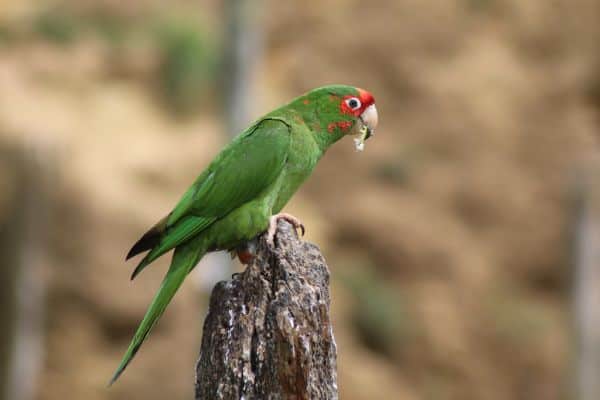
This captivating parrot species boasts a remarkable blend of colors that will leave you in awe. With vibrant emerald-green feathers adorning its body, the Mitred Parakeet stands out in any flock. Its head is adorned with a brilliant red mask that stretches from its forehead to its cheeks, adding a touch of fiery elegance to its appearance.
Measuring approximately 12 to 14 inches in length, the Mitred Parakeet strikes a perfect balance between size and charm. Its compact stature allows for agile and graceful movements as it traverses the treetops. With a wingspan spanning around 20 to 22 inches, this bird takes flight with impressive precision and agility, showcasing its aerial prowess.
Diet
This parakeet species is known for its omnivorous nature, which means it enjoys a wide range of food sources to fuel its energy and maintain a healthy lifestyle. In the wild, Mitred Parakeets predominantly feed on fruits, nuts, seeds, and blossoms found in their natural habitat.
They have a particular fondness for fruits such as berries, apples, pears, and figs, relishing in their juicy flavors. Nuts, including almonds and walnuts, provide essential fats and proteins in their diet, contributing to their overall well-being.
Aside from plant-based foods, Mitred Parakeets also exhibit opportunistic feeding behavior by consuming small insects, larvae, and even occasional small vertebrates like lizards or small birds.
Nesting
With meticulous precision, these parakeets transform their chosen nest cavity into a comfortable sanctuary for their offspring. Using their beaks and agile feet, they line the nest with a combination of twigs, leaves, bark, and even soft materials like moss or feathers. This carefully constructed lining provides both insulation and cushioning, ensuring a safe and cozy environment for the eggs and hatchlings.
During the nesting season, the female Mitred Parakeet lays a clutch of 3 to 5 eggs, which she diligently incubates for approximately 23 to 26 days. The male actively supports the female during this period, providing food and standing guard against potential threats, showcasing their commitment to successful reproduction.
Once the hatchlings emerge from their eggs, the parents diligently care for their young, feeding them regurgitated food rich in nutrients. As the nestlings grow, their fluffy down feathers are gradually replaced by vibrant plumage, offering a glimpse of the remarkable colors they will possess as adults.
Mitred Parakeets demonstrate a strong sense of community, with neighboring nests often found in close proximity. This cooperative nesting behavior fosters social bonds within the colony and provides added protection against predators.
While these parakeets primarily nest in the wild, some captive individuals may exhibit nesting behaviors when provided with suitable nesting boxes or cavities. This allows them to express their natural instincts and engage in the joys of parenthood.
Behavior
Mitred Parakeets are highly social creatures, forming tight-knit flocks that exhibit strong bonds within their community. Their vibrant plumage and energetic demeanor add a burst of color and liveliness to any environment they inhabit.
One of the most remarkable behaviors of Mitred Parakeets is their ability to communicate through a diverse range of vocalizations. From joyful squawks to melodic chirps, these parakeets use their voices to convey messages, establish territory, and strengthen social connections within their flock. Their vocal repertoire is a symphony that echoes through the treetops, adding an enchanting aura to their presence.
These parakeets are also known for their acrobatic displays and playful antics. They love to engage in aerial acrobatics, darting and swooping through the air with impressive agility and grace. Whether performing daring mid-air maneuvers or engaging in spirited chase games, their joyful energy is contagious and fills the air with a sense of exuberance.
Mitred Parakeets are curious by nature, constantly exploring their surroundings and investigating objects with their beaks and nimble feet. They possess an innate intelligence that allows them to quickly learn and adapt to their environment, making them highly trainable and interactive pets.
In the wild, Mitred Parakeets are foragers, using their strong beaks to crack open seeds and fruits. Their foraging behavior plays a crucial role in seed dispersal and maintaining the ecological balance of their habitat.
Within their flock, Mitred Parakeets display a strong sense of camaraderie, often preening and grooming each other, which reinforces social bonds. They also engage in communal roosting, huddling together for warmth and protection during rest periods.
Habitat
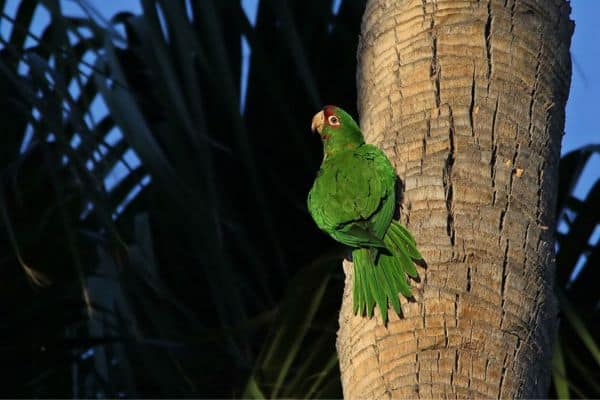
The Mitred Parakeet thrives in diverse habitats, including tropical rainforests, arid woodlands, and even urban environments. These adaptable birds are primarily arboreal, navigating the canopy with ease. From dense rainforests to city parks, the Mitred Parakeet brings its vibrant colors and lively presence to a range of habitats.
Range
The Mitred Parakeet is a naturalized resident in Hawaii, originating from escaped birds or naturalized populations since the 1980s. It formed a breeding population on Maui for at least 15 years, and sightings have been reported on Hawaii Island and Oahu.
Efforts to control their impact have been undertaken, but a small population remains in the wild. Further documentation is needed to confirm their presence on other islands.
Conservation Status
The conservation status of the Mitred Parakeet (Psittacara mitratus) is currently listed as “Least Concern” by the International Union for Conservation of Nature (IUCN). This status reflects the species’ relatively stable population and its adaptability to various habitats.
Interesting Facts
1. Intelligent problem-solvers
Mitred Parakeets are known for their intelligence and problem-solving abilities. They can quickly learn to manipulate objects and solve puzzles, showcasing their cognitive prowess.
2. Diurnal behavior
Mitred Parakeets are diurnal, meaning they are active during the day and rest or sleep at night. Their lively activities, vocalizations, and vibrant colors make them a delightful sight to behold in daylight.
3. Playful nature
These parakeets have a playful and curious nature, often engaging in games, toy interactions, and exploring their surroundings. They require mental stimulation and enrichment to keep them happy and healthy.
4. Hybridization
Mitred Parakeets have been known to hybridize with other closely related parrot species, resulting in unique hybrid offspring with mixed characteristics and traits.
5. Cultural significance
Mitred Parakeets hold cultural significance in some regions, being featured in indigenous folklore, artwork, and celebrations. They symbolize vitality, freedom, and the connection between humans and nature.
Frequently Asked Questions
1. Do Mitred Parakeets talk or mimic sounds?
Yes, Mitred Parakeets have the ability to mimic sounds, including human speech. While not all individuals may exhibit this talent, some Mitred Parakeets can learn to imitate words, phrases, and various environmental sounds.
2. How long do Mitred Parakeets live?
Mitred Parakeets have an average lifespan of 20 to 30 years or even longer in captivity with proper care, nutrition, and a suitable environment.
3. Can Mitred Parakeets be kept with other birds?
Mitred Parakeets can coexist with other birds, including those of similar size and temperament. However, careful introduction, monitoring, and ensuring adequate space and resources are essential to minimize potential conflicts.
4. Do Mitred Parakeets engage in bathing?
Yes, Mitred Parakeets enjoy bathing to keep their feathers clean and healthy. They may splash around in shallow water dishes or misting sprays, exhibiting their natural instinct for grooming and self-care.
5. How do Mitred Parakeets sleep?
Mitred Parakeets typically roost in tree cavities or sheltered branches for sleeping. They tuck their heads under their feathers and often sleep in groups for added safety and warmth.
